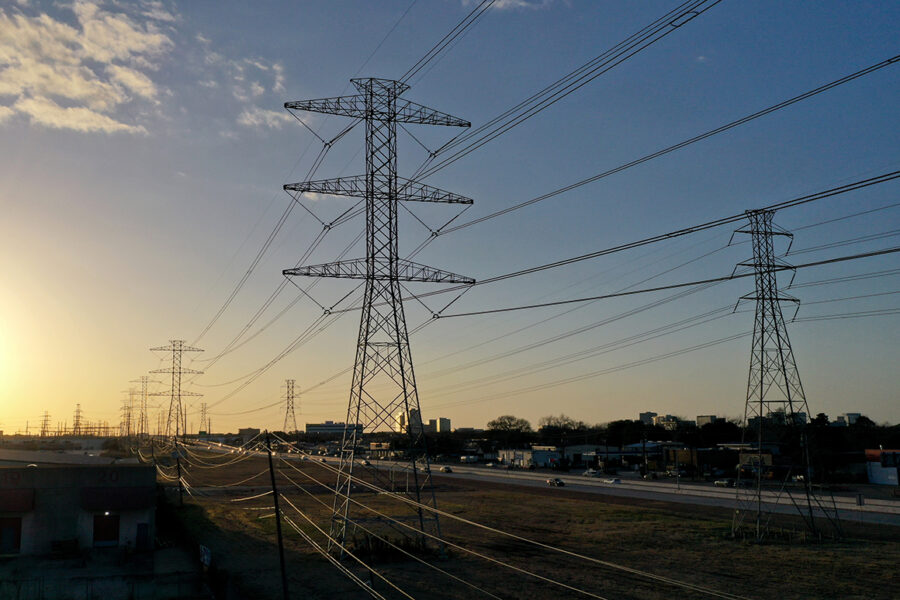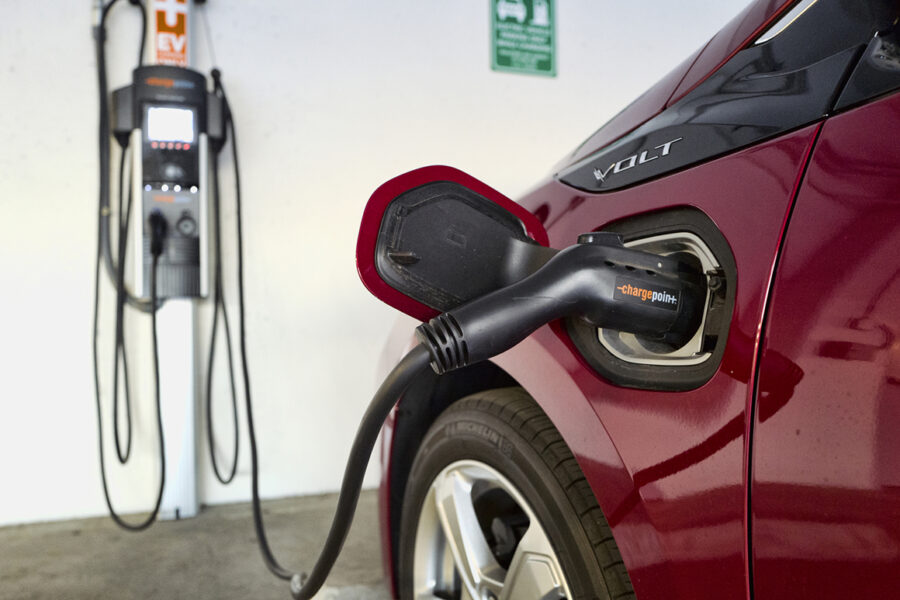Biden’s sweeping climate goal comes down to one thing

President Joe Biden’s ambitious climate pledges come down to one main question: How much greener can he make the U.S. power grid?
The United States has made almost no progress in cutting greenhouse gas emissions from its other major carbon sources — vehicles, buildings, factories and farms. The U.S. reduced emissions by only 12 percent from 2005 through 2019, so it will have to more than triple its carbon-slashing pace to meet the target Biden announced Thursday: 50 to 52 percent reductions from 2005 levels by 2030.
The one bright spot, accounting for virtually all the reductions that America has achieved, has been the rapid transformation of U.S. electricity. The power sector’s emissions have already decreased by more than one-third, as dirty coal-fired power plants have been replaced by cleaner-burning natural gas and zero-emissions wind and solar. The nation’s non-electricity emissions actually increased a bit before Covid put the economy on pause.
So while Biden’s $2 trillion-plus infrastructure plan aims for tectonic shifts throughout the economy, its success will depend mostly on cleaning up the grid even faster. This is partly because electricity is the only sector with clean, cheap and effective alternatives to fossil fuels that are already expanding their market share. And it’s partly because clean electricity will magnify the climate benefits of electrifying sectors like transportation in the future.
“The power sector still has the lowest-hanging fruit,” said Ed Crooks, vice chair for the Americas at the energy consultancy Wood Mackenzie. “The rest of the economy looks a lot more challenging.”
The global game plan for phasing out fossil fuels is fairly straightforward: Shift to clean electricity while electrifying as much of the rest of the economy as possible. The U.S. has had remarkable success with the first part, eliminating more than a third of its electricity emissions since 2005 by retiring more than half its coal plants. It’s the rest of the economy that’s been a problem. Transportation emissions decreased just 5 percent before the pandemic, industry emissions barely budged, and emissions from buildings and farms slightly increased. Government mandates for more energy-efficient furnaces and fuel-efficient cars have been offset by consumers buying bigger houses and more gas-guzzling SUVs.
Now Biden wants an economywide sprint to halve emissions, and electricity is the only sector with a running start. The White House did not unveil specific 2030 targets for various sectors Thursday, but energy analysts believe that electricity emissions may have to drop more than 80 percent from 2005 levels to make the math work, and Biden has already set a goal of a completely emissions-free power grid by 2035. In a press briefing, a senior administration official rhapsodized about all kinds of solutions with the potential to replace fossil fuels, from hydrogen-fueled heating for industry to all-electric Ford F-150s for transportation, but he hinted that the power sector will lead the way toward a decarbonized future.
“We know that’s the sector on wheels. It has the momentum,” the official said. “The right move is to lean into the opportunity to continue to modernize our grid.”
The collapse of coal over the last decade has been driven by Obama-era pollution regulations, cheap fracked natural gas, massive reductions in the cost of renewables, and an extraordinarily successful legal and political campaign to force utilities to face economic and environmental reality. Biden’s $2.5 trillion infrastructure plan aims to accelerate the transition by expanding tax credits for wind, solar and batteries that can store power when the wind isn’t blowing and the sun isn’t shining; investing in transmission lines that can move renewable electricity where it’s needed; and enacting a clean electricity standard that would force utilities to produce as much as 80 percent of their power without emissions.
Bruce Nilles, who helped jump-start the greening of U.S. electricity when he led the Sierra Club’s relentless Beyond Coal campaign, says America needs to get rid of all of its coal plants to meet Biden’s 2030 target, and probably half its gas plants as well. He says that with strict government mandates as well as generous government investments, the U.S. could not only reduce annual electricity emissions by more than a gigaton in this decade — it could also set the stage for much larger reductions in other sectors in future decades if innovations like electric vehicles for transportation and electric heat pumps for buildings can reach critical mass.
Starla Yeh, director of policy analysis for the Natural Resources Defense Council, has a model that expects the power sector to produce 62 percent of America’s emissions reductions by 2030, even though it only produces about 25 percent of America’s emissions. Transportation already passed electricity as America’s largest source of emissions in the last decade, and industry is expected to pass transportation in this decade.
“We’ve got to keep doing what’s working in the power sector, but we also have to start getting serious about the other sectors,” said Nilles, who is now pushing broader decarbonization strategies as the head of the Climate Imperative foundation.

That’s where the numbers get even more daunting. For example, only about 2 percent of the vehicles sold in the U.S. are electric. And only about 17 million vehicles are sold in the U.S. every year, out of 280 million vehicles on the road. Biden’s infrastructure plan would invest $174 billion in electric cars and trucks, but even if he succeeds in getting it through Congress, and even if it succeeds in jacking up all-electric vehicle sales, it would move only a small percentage of the U.S. fleet off gasoline. Homeowners replace their furnaces even less frequently than drivers replace their cars, so weaning home heating off carbon could be even slower.
Meanwhile, the technological innovations that will be needed to decarbonize heavy industries like steel and cement are still expensive and unproven. Aviation and shipping also seem likely to remain fossil-fueled for the foreseeable future. The farm sector is yet another question mark; there’s a lot of hype around the potential of “regenerative agriculture” to help fix the climate, but not a lot of evidence that it helps store more carbon in fields or pastures.
Frank Maisano of the Bracewell Policy Resolution Group, which represents utilities as well as other energy interests, thinks it’s a bit unfair to expect utilities to keep shouldering the carbon-cutting burden for the rest of the economy; a tough clean electricity standard could force them to start retiring viable new gas plants in addition to outdated coal plants. But he understands that it’s easier to force 600 utilities to change how they generate electricity than to force 300 million Americans to change how they drive and live and cook. His real complaint is that even if the U.S. power sector cuts its emissions by 80 percent, no plausible scenario exists for the other sectors to do enough to meet Biden’s overall 2030 target.
“We have to look at these challenges with a dose of reality, or else we’ll hurt ourselves in the eyes of the international community,” Maisano said. “These numbers just don’t add up.”

The Biden 2030 target is clearly a stretch, although some analysts believe it’s achievable with continued cost reductions in clean technologies, as well as some cooperation from Congress and the Supreme Court. But Biden’s ultimate goal is a net-zero economy by 2050, which would be in line with the Paris agreement’s targets for avoiding the worst climate outcomes. For the next decade, the trajectory may be more important than the exact numbers.
“It’s like steering an ocean liner,” said climate scientist Zeke Hausfather, director of climate and energy at the Breakthrough Institute. “What really matters is that the ship is turning in the right direction.”
There’s little doubt that in this decade, electricity will continue to steer the ship, because wind and solar (along with electricity-saving LED lighting) are the most cost-competitive green technologies. But if Biden can also promote a future where more cars and delivery vans and stoves and heating systems go electric, the impact of the cleaner grid will be even greater. It’s not clear whether he’ll succeed, but he clearly intends to try.
“We’ve never had an administration this committed to resolving the climate crisis,” said Yeh, the NRDC policy analyst. “It’s really a special moment in time.”
Go To Source
Author: POLITICO

